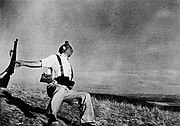http://www.photonhead.com/simcam/
SLR - single shot reflex.
Apperture- one way of controlling the intake of light by widening and shortening the lense. widening the lense is used in dark areas or night to help gather as much light intake and shortening the lense is or lighter or day pictures for less light intake. sizes between 2.4-22
Shutter speed- the slower the shuter the shutter speed exposes mored light to the film and the faster exposes less. speeds between 4 seconds and 1/4000 of a second.
if using hand held you have to set the speed as 1/25 of a second as minimum as the natural shake of the hand causes bluring on anything slower.
DOF depth of field the ower the F no. the smaller the DOF and vice versa.
 For us to get this picture we set up and waited for the perfect image but the camera was slightly out again and this is our final image. I like this picture because of the slight blurring giving the effect of movement.
For us to get this picture we set up and waited for the perfect image but the camera was slightly out again and this is our final image. I like this picture because of the slight blurring giving the effect of movement. Out of the pictures we took, i like this picture this most, as it seems slightly humorous because of the movement and efect given of by this image.
Out of the pictures we took, i like this picture this most, as it seems slightly humorous because of the movement and efect given of by this image. In this picture we have tried to anticipate and succesfully take a picture using the decisive moment technique of a blue van still in motion.Unfortunately we had to try many times as the camera either didn't take picture at right times and zoom didnt work but we settled with this picture in the end. i don't really like this picture as it wasn't what i planned to have a final piece.
In this picture we have tried to anticipate and succesfully take a picture using the decisive moment technique of a blue van still in motion.Unfortunately we had to try many times as the camera either didn't take picture at right times and zoom didnt work but we settled with this picture in the end. i don't really like this picture as it wasn't what i planned to have a final piece.






















